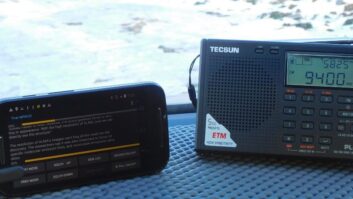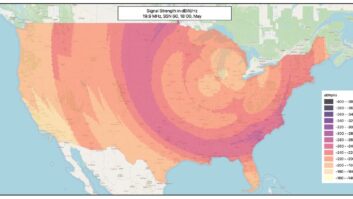
Congress has approved cuts in shortwave transmission sought by the Broadcasting Board of Governors.
The BBG is an independent federal agency that oversees U.S. international broadcasting networks. Its broadcasters include the Voice of America and the Office of Cuba Broadcasting; and three nonprofit grantees: Radio Free Europe/Radio Liberty, the Middle East Broadcast Networks and Radio Free Asia.
We had noted that the BBG had planned to end some shortwave broadcasts as part of its plans to streamline operations and avoid duplication across its five networks. As part of that effort, some shortwave broadcasts have been terminated for VOA, RFE/RFL and RFA.
The BBG told RW: “We continue shortwave to those countries where these transmissions are still reaching significant audiences or where there are no reasonable alternative platforms at a lower cost to the BBG,” according to spokeswoman Leticia King. “The shortwave reductions will save U.S. taxpayers almost $1.6 million annually.”
We reported earlier the cuts were part of the BBG’s FY2015 budget request of $721.26 million, which lawmakers have now approved.
There are no reductions in staff or programming as a result of the changes — these are transmission platform reductions only, she noted. Programming continues to be available through other media.
Shortwave transmissions continue in many languages including to key shortwave markets like North Korea, Nigeria, Somalia and the Horn of Africa. Transmissions also continue on other platforms including AM, FM, TV and online.
The BBG provided a detailed list of shortwave cuts, the reasoning behind those, as well as where shortwave broadcasts continue.
VOA Azerbaijani
● Cuts: 30 minutes shortwave
● Continuing Distribution: Satellite TV (HotBird) and satellite audio (TurkSat); multimedia web and mobile sites and social media
● Shortwave is used by just 2% of adults weekly in Azerbaijan, and does not yield significant audiences for the service (0.4% weekly reach on radio in BBG’s most recent survey). By contrast, satellite dish ownership is widespread, at 56%, and 18% use the Internet weekly. The service has both satellite and online products, which are far more likely to reach audiences in Azerbaijan.
VOA Bangla
● Cuts: 1 hour shortwave
● Continuing Distribution: 1 hour medium-wave (AM); FM and TV affiliates; multimedia web and mobile sites; social media
● Shortwave is not widely used in Bangladesh (just 2% weekly), and the majority of the service’s audience comes to its programming via FM and TV affiliate networks in the country.
VOA English (in Asia)
● Cuts: 6.5 hours shortwave (2 hours of programming that was repeated)
● Continuing Distribution: Some medium-wave; multimedia web and mobile sites and social media
● Outside of sub-Saharan Africa, English speakers are rarely users of shortwave radio. They are more likely to be educated and affluent, and to have access to a broad range of media. Years of BBG research questions on consumption of VOA English on shortwave have failed to find any significant audiences outside Africa, in large part because usage of shortwave radio in other regions is mostly very low.
VOA Lao
● Cuts: 30 minutes shortwave
● Continuing Distribution: 30 minutes medium-wave; 7 affiliates in Thailand on Lao border, with reach into Laos; multimedia web and mobile sites; social media
● Shortwave is very little-used in Laos — less than 1% of adults report listening to shortwave radio weekly. In BBG’s most recent research in Laos, no surveyed listeners reported using the shortwave band to access VOA content. A majority (66%) hear VOA on FM, through affiliate stations on the Thai border that carry VOA content (Laos is so small that border FM stations have decent penetration into the country).
VOA Special/Learning English
● Cuts: 5.5 hours shortwave
● Continuing Distribution: Learning English programs continue on shortwave on English to Africa. 30 minutes medium-wave; multimedia web and mobile sites, including special interactive teaching products; social media, including social English lessons
● BBG audience research indicates strong interest in learning English, but very limited shortwave listenership to VOA Learning English, outside a few select markets. The service is working more closely with other VOA language services to create English learning products for distribution on more popular channels. And Learning English offers a variety of digital products that are increasingly popular, including a Skype call-in show, videos on YouTube, and a website featuring both audio and transcripts for online audiences to follow as they listen.
VOA Uzbek
● Cuts: 30 minutes shortwave
● Continuing Distribution: Satellite audio and TV (HotBird); FM and TV affiliates in neighboring countries; multimedia web and mobile sites (with circumvention tools deployed); social media
● SW is not widely used in Uzbekistan (just 2% weekly), and does not yield significant audiences for the service (0.3% weekly). Adults in Uzbekistan are much more likely to own a satellite dish (13%) or use the Internet (12% weekly) than to use shortwave, so the service provides content on those platforms. Uzbekistan is an especially difficult market to penetrate with USIM content, but shortwave is not an effective platform for the country.
RFE/RL Persian (Farda)
● Cuts: 1 simultaneous shortwave frequency for 6 broadcast hours
● Continuing Distribution: Shortwave on multiple frequencies for all 24 broadcast hours remains on, in addition to 24 hours daily medium-wave; “Radio on TV” on VOA Persian stream; 24 hours daily satellite audio with slate plus 24-hour audio on 4 other satellites including Hotbird, the most popular satellite in Iran; multimedia website (with circumvention tools deployed); social media; mobile app with anticensorship proxy server capability built-in.
● This is only a reduction to the number of simultaneous frequencies during some of the broadcast day. Shortwave radio, with 5% weekly use in 2012, is considerably less popular than other platforms on which audiences can access Farda content, such as medium-wave (10% weekly use), satellite television (26% own a dish, and 33% watch satellite television weekly) or the Internet (39% weekly use).
RFA Lao
● Cuts: 2 hours shortwave
● Continuing Distribution: 5 FM radio affiliates in Thailand provide cross-border coverage; multimedia web and mobile sites; social media
● Shortwave is very little-used in Laos — less than 1% of adults report listening to shortwave radio weekly. RFA Lao’s listeners come overwhelmingly via FM stations on the Thai border — 94% of past-week listeners report hearing RFA on FM. (Laos is so small that border FM stations have decent penetration into the country).
RFA Vietnamese
● Cuts: 2 hours shortwave
● Continuing Distribution: Medium-wave coverage of all broadcast hours remains on; multimedia web and mobile sites (with circumvention tools deployed) include webcasts and other videos; social media
● Shortwave radio is very little-used in Vietnam — less than 1% of adults report any weekly use of the waveband, and RFA reaches just 0.2% of adults weekly on radio. Medium-wave is slightly more popular, but the future for USIM in Vietnam is likely online: 26% of Vietnamese use the Internet weekly now (with much higher rates among certain populations, like the young and the well-educated), and three in four personally own a mobile phone. While Vietnam attempts to block access to sensitive sites, Vietnam is actually the most active country in our most popular Internet Anti-Censorship tools with almost 600 million hits per day.
Languages that continue on shortwave:
VOA
● Afan Oromo/Amharic/Tigrigna to Ethiopia and Eritrea
● Bambara
● Burmese
● Cantonese
● Dari
● English to Africa
● English to South Sudan
● French to Africa
● Hausa
● Khmer
● Kinyarwanda/Kirundi
● Korean
● Kurdish
● Mandarin
● Pashto (to FATA and Afghanistan)
● Portuguese to Africa
● Somali
● Swahili
● Tibetan
● Shona/Ndebele/English to Zimbabwe
OCB
●Spanish to Cuba
RFE/RL
● Avar/Chechen/Circassian
● Belarusian
● Dari
● Pashto (to FATA and Afghanistan)
● Persian
● Russian
● Tajik
● Turkmen
● Uzbek
RFA
● Burmese
● Cantonese
● Khmer
● Korean
● Mandarin
● Tibetan
● Uyghur
MBN
● Arabic (Afia Darfur to Sudan/Chad)











